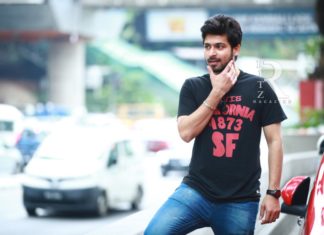I remember going to Calcutta on a school trip, before they changed the city’s name to Kolkata. I was probably in 9th grade and from what I remember; we didn’t venture into the lanes of Park Street or Tangra or even Dacres to try out the different dishes available, sticking instead to pucchkas (pani-puri)! My initiation to what Bengali food happened finally when I was introduced to Indronil and Sumita aka Mou Ganguli, owners of Call of Bengal. Needless to say, I’ve become a fan.
Text-Deeksha Marur, photo credits: Santosh Kumar

A quaint little restaurant opposite DLF in Gachibowli, Call of Bengal with its simple interiors operates on the mantra of letting the food talk for itself. And boy, trust us, when we say there was absolute silence once the food was brought out. As we waited for our guests, film director Mani Shankar with his son Bhairav and friend Hamed Saberi to arrive, we were given a brief about the different things that were going to be served to us. “A lot of people are under the impression that Bengali food is only about fish and rasgulla,” states Mou, our curator for the evening. She tells us that Bengali food is not just ingredients, but about the stories, the history and the culture of the place, all of which make the overall cuisine so famous and delicious at the same time.
Enter our guests. Despite advance warnings of Mani Shankar being on an eternal diet, we start our gastronomical lesson with a preface – a portion of Prawn Cutlet from Park Circus. One bite of this crispy cutlet and all the restrictions and diets simply fly out of the window. Served with mustard sauce this cutlet almost melts in your mouth. Bhairav, who has just returned from his stint at Oxford University, UK, happens to be a foodie and loves Bengali cuisine. “There are quite a few Bengali joints in the UK that are pretty good.” Hamed, Mani’s close friend and a well-known Hyderabadi socialite is open to trying different cuisines.
Moving on to the first lesson, College Street Calling – we are given a little history to the name behind this section and served a portion of Luchi Aloo Dum. On being served the luchis, we notice they aren’t anything like the puris we get in the city. Mou says, “Luchis are lighter than puris. It is thinner on the upper crust while the lower is thicker.” Accompanied by a tasty and slightly spicy Aloo Dum, this makes for a perfect combination and a meal by itself. We’re on to the Moghalai Parota which is thick roti stuffed with egg and onions – a super-heavy dish, but delicious nonetheless. Bhairav happens to be the only one ready for a second helping. By now, Mani’s diet has been compromised. He says, “You are really spoiling me! I usually write a log for whatever I’ve eaten all day; this is just not going into that log. My dietician will flip!”
Out from the College Street on to Park Street with the most delicious Fish Florentine you can find in the city. All of us were fans! The tender fish, with a creamy and cheesy spinach bake, was to die for. Highly recommended by all three of our guests, this is one dish you absolutely have to try. From the Dacres Lane, comes the Chingri Malai Curry accompanied by a portion of rice. The tiger prawn curry had to be eaten just one way – forget fine dining and dive hands-in; break the shells and dig into the succulent meat of the prawn. It is hard to explain the deliciousness of this curry in words.
And while Dacres happens to be our last stop, we end our meal with Patishapta, a dessert recipe given to Mou by her grandmother. For those who haven’t tried this before, think Kajikayas because the taste is pretty similar to that. The coconut and jaggery stuffing had the right kind of sweetness to it and was a perfect way to end our evening.
[wzslider]















